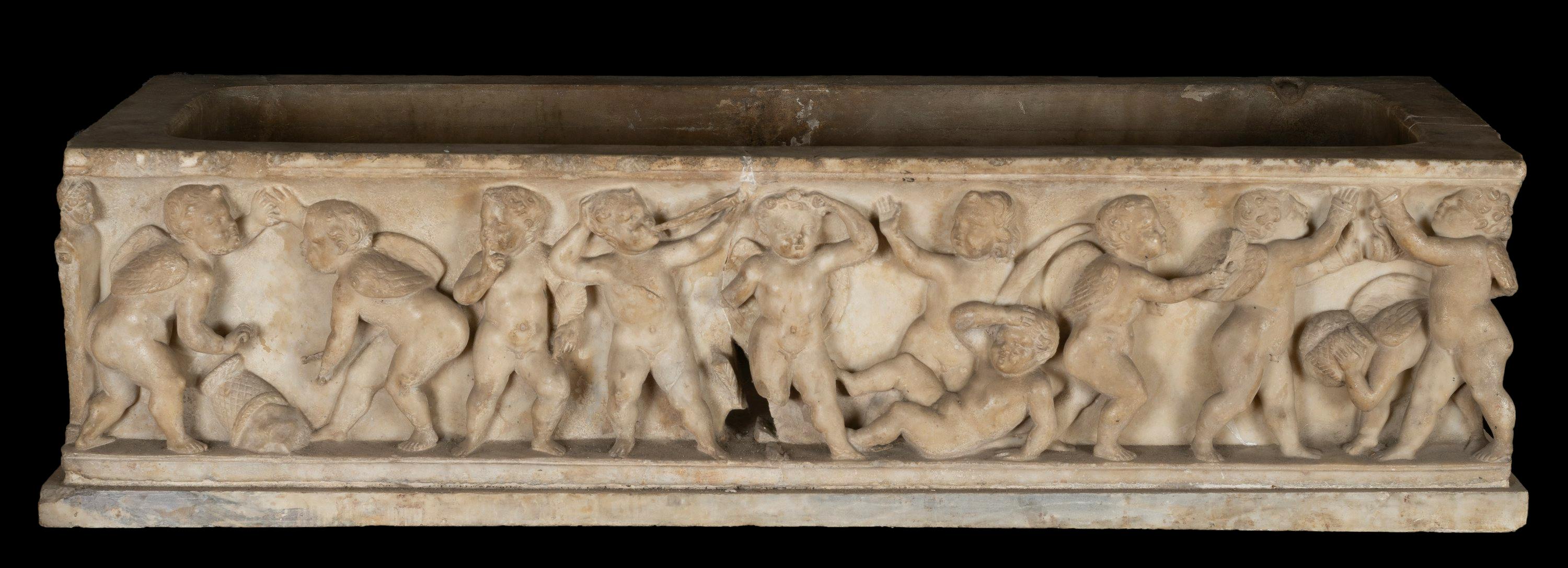Sarcophagus with Erotes in Athletic Contests
The sarcophagus, destined to host the corpse of a child, can be dated to between 140 and 150 A.D. and bears a continuous frieze decoration on the front and the short sides. The subject of the decoration is a series of Erotes engaged in athletic activities: on the front we can count eleven cherubs divided into three separate scenes related to wrestling matches (victory scene in the centre and fights in the presence of referees at the sides); on the short side on the left, two assistant Erotes prepare a third one for a fight, by taking an ointment (ceroma) from a vase and spreading it on his body; instead, a running scene is depicted on the right-hand side of the receptacle.
The figures are organised in isolated groups, with energetic forms, but a softly modelled finish.
The Erotes, often depicted as winged children, became a constant motif of Hellenistic art, but also often appeared in Roman art, in the form of Erotes, Cupid, or cherubs, and they can be found in many sarcophagi and reliefs, engaged in a series of activities. These include compositions portraying races in the circus, or scenes of life in the countryside where they are busy harvesting grapes or wheat or picking fruit; there are also hunting Erotes, musical Erotes, Erotes riding on dolphins, or Erotes associated with other figures or composing continuous scenes applied to the front of sarcophagi as decoration. Often, as in this case, the Erotes were depicted in gym scenes, or busy playing or fighting. “The many Hellenistic and Roman figurations of Erotes or cherubs (in Rome Eros was called Love or Cupid) are often symbols of the novice during the initiation process, or of the soul in the afterworld, an event to which the story of Love and Psyche is related, narrated by Apuleius in the Metamorphoses.” (Antichità classica vol. I, Milano, 2005, p. 518).
As for the Sarcophagus with putti in athletic scenes located in Paris (Musée du Louvre inv. 329), in this case too, this is not a representation of the afterworld where the deceased continues playing his favourite games, but rather a metaphor for human life: athletic exercise prepares a person for the final beatitude, in a sort of heroization of the deceased, similar to that performed by culture, which is expressed in the sarcophagi with the representation of Philosophers or Muses. So here too there is probably an underlying philosophical perspective that equates athletic education with intellectual education and that considers gymnastic activities, with all their victories and defeats, as a mirror of life.
The relief decoration on the sarcophagus is well-preserved. The base of the receptacle is modern, whereas the presence of a hole on the side at the back probably indicates that it was used as the basin of a fountain.
The subject and dimensions of the object lead us to identify it as a work from the Roman Capranica-Della Valle collection and, like another sarcophagus from the same collection (Sarcophagus with the triumph of Bacchus, Uffizi Gallery, Inv. 1914, no. 152), purchased by Cardinal Ferdinando de’ Medici in 1584 and placed in the garden of Villa Medici on the Pincian Hill in the same year. From Rome, the piece was then transferred to Florence before 1704, the year in which it appeared in the Uffizi Inventory of Antiquities. Located in the Room of Inscriptions, it was subsequently moved to the Uffizi sculptures deposit, where it is still kept today.
